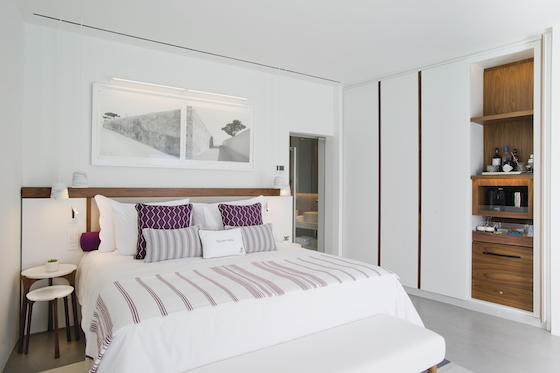For a few years now, beacon technology has been on the up and up in hotels as a way to communicate with guests on-property. Using devices that emit Bluetooth Low Energy, messages are pushed to mobile apps about what’s open at the hotel, where to find certain facilities, to complete the check-in process and even advertise drink specials at the lobby bar.
Marriott International, and subsequently Starwood Hotels and Resorts Worldwide, took the lead on beacons several years ago with beacon-powered LocalPerks offers. Early last year, Marriott announced its Mplaces beacon technology, which it was rolling out to 500 hotels. The technology uses data and location awareness to ping guests with personalized alerts during their stay (guests do need to download the Marriott Rewards app to get these notifications.) The goal is to give guests relevant information that is useful right in that moment, says George Corbin, chief digital officer at Marriott International.
“For example, if we know you are a frequent fitness center user, we can notify you upon arrival that the fitness center is on the third floor and the hours it’s open,” he said in an interview last year.

Give (offers) and take (information)
Other big brands have followed suit, including Hilton Worldwide, Hyatt, IHG and RL Hotels, to name a few. Crafting the messages, and in some cases creating the offers, has opened up an entirely new aspect of hotel marketing. And the results are easy to see.
For hotel guests, beacons deliver pertinent and interesting information right to their handheld devices. For hotels, beacons can drive more sales in ancillary departments like spa, F&B, and the gift shop – which is why beacon technology is hugely popular in retail environments.
Beacons also allow hotels to collect detailed information about the guest and their movements during their stay. (Yes, that’s kind of creepy but it’s an all-too-familiar byproduct of tech these days.) All that big data gets stored and sorted and analyzed and hopefully churned out into an even smarter marketing plan. Hopefully.
Recently some hotels have experimented with beacons beyond prompting guests to book a massage or order a cocktail. One hotel brand uses beacon technology to help guests explore the property’s artwork.
The Grace Santorini, a boutique hotel in Greece, developed an interactive app, “ARt by Grace” that shows off the property’s limited-edition photographs by Yiorgos Kordakis and the surrounding scenic area. Using a combination of image recognition and beacons, the app will unlock video footage from the location shown in the guest room photographs. (The collection of photographs also is available to buy in the hotel’s gift shop.) “Guests have particularly enjoyed seeing the photography come to life through video,” says Lena Livanidou, head of Europe at Grace Hotels.
The Hyatt Regency McCormick Place in Chicago uses beacon technology with a proprietary app to track inventory, particularly with items loaned to guests such as rollaway bed and cribs. The technology even integrates with the hotel’s property management system. Not only did it increase employee response time, but the beacons, which are tagged to the hotel items, help the employees know exactly where each item is at a given time.
Calling all employees
Indeed, using beacons for quicker employee response time (the device can be embedded in the name tag, and whoever is closest to a guest room that’s the source of a request can complete the task) is a smart and easy use of the technology to increase operational efficiency. Other back-of-the-house options for beacons include tracking room service trays for pick-up, panic buttons for employees, and outfitting visiting vendors to the hotel with ID cards containing beacons so as to keep track of their whereabouts.
Beacons placed in the guest rooms through an all-in-one charging device are another possibility. Typically most beacons are placed in the public areas of the hotel encouraging them to explore the property, but in-room beacons would push messages to guests about certain features and services in the room, like in-room dining. Of course, this could be a case of beacon overload, and a hotel may risk turning off the guest with consistent bombardment of messaging.
But it’s emerging technologies (emerging for hotels, anyway) such as virtual reality, augmented reality and artificial intelligence that hotels are suddenly starting to pay more attention to. All of these remain opt-in by the guest, of course, but they do give customers more ways to experience a hotel during their stay, and leave little data breadcrumbs while they are at it.
Yet beacons aren’t dimming just yet. The good news is that these technologies often work with beacons to deliver the new services to guests. But in the end, all that might be needed is a super fast WiFi network. To be continued…
Contributed by Juliana Shallcross
